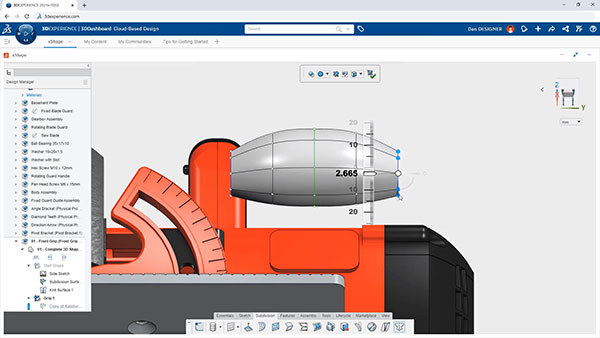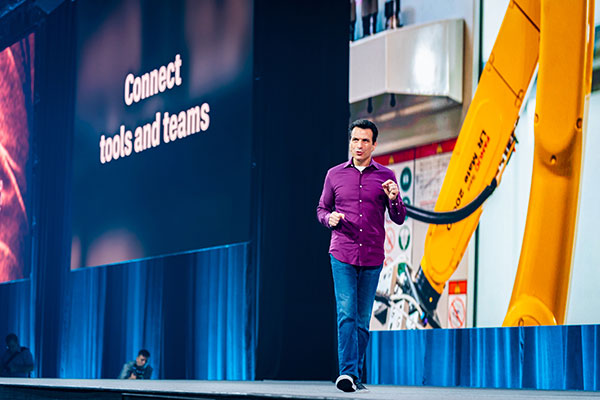
Dassault Systèmes offers 3DEXPERIENCE Works as a cloud-based design solution. Image courtesy of Dassault Systèmes.
Latest News
March 24, 2023
CAD interoperability—or lack of it—was once a major collaborative design hurdle. Formats are constantly evolving, getting richer as the vendors compete with one another to be the first to support 3D printing, augmented reality/virtual reality (AR/VR), and whatever the emerging practices demand. This makes interoperability a moving target.
For this article, we spoke to some insiders to see if the interoperability albatross is still tied around the collaborative project’s neck. As it turns out, the bird is afraid of the cloud.
What Is Your Problem?
Jonathan Girroir, director of marketing at Tech Soft 3D, believes a big part of the interoperability puzzle has already been solved. He’s referring to the format-to-format conversion issues that used to plague collaborative projects. His firm rightfully deserves a chunk of the credit for the progress.
“We provide access to more than 30 file formats,” he says. “About half our time is devoted to making sure we can read the latest CATIA, SolidWorks and other CAD formats.” Tech Soft 3D’s HOOPS Exchange SDK covers formats from the major design software makers, including Siemens, Autodesk, Dassault Systèmes and PTC.

CAD formats are constantly evolving. The latest versions, for example, include support for 3D printing. There’s also competition among the vendors to support newer, exotic materials, such as composite plies. For a translation technology supplier, just keeping up with the latest changes is challenging.
For file-to-file conversion, the nonproprietary STEP is still widely used as one of the standard export options in 3D design packages. Introduced in the mid-1990s, it continues to evolve, according to Girroir, “particularly the STEP AP 242, which enables you to add [product manufacturing information (PMI)].”
As CAD’s relationship with AR/VR grows, Tech Soft 3D also envisions more robust support for file formats commonly used in games and films. “The big ones are FBX and glTF, and more recently USD,” Girroir says.
Originally developed by Pixar, USD is also the backbone of Omniverse, the immersive simulation and visualization platform from NVIDIA. As a strong candidate for hosting industrial digital twins, it attracts significant attention from the CAD community.
Format-to-format translation will never be 100% accurate, and some data loss or translation errors are unavoidable, but the level of accuracy possible is more than adequate for many use cases, Girroir says.
“Do you want to do design review or clash detection? Do you want to bring in the drivetrain and the exterior from different CAD systems for a system-level visualization? That’s not a problem,” he says. The stumbling block is editing—in particular, editing parametric features in one CAD program with another package.
But even with that, “moving around small, simple features won’t be a problem. But occasionally there’s a complex corner case that requires extra care or may not be fully transferable,” he says.
The Twilight of Files; Dawn of the Cloud
Kevin Schneider, senior director of product design and manufacturing software, Autodesk, believes interoperability is a legacy of file-based workflows. Technically, PDF and STEP are digital data formats, still widely used in many engineering projects, but to Schneider, they are part of the analog past.
“In the file-based multi-CAD world, you need translators. You’re dealing with opaque formats only the authoring application can understand. So, you have to license these or get them from the vendors,” he says. The use of translators inevitably results in some data loss, compromising integrity of the original design.
Different CAD formats can coexist in the cloud because “the cloud normalizes them,” Schneider says. “As a user, you won’t need a PTC library or SOLIDWORKS library to read these files. The underlying data has either been preprocessed or is cloud native for easy access.”
This explains Autodesk’s push for the cloud-friendly Autodesk Fusion 360 as the preferred collaborative design platform.
“We’ve invested in the technology to take the non-cloud-native formats from our own applications and from our competitors and do the data extraction to make it more accessible,” Schneider says.
File import solves the interoperability issue to an extent, but is less than ideal. The ability to convert a native CAD file into a STEP file for import, for example, “is limited to a moment in time,” Schneider says.
In Fusion 360’s cloud-based environment, the imported data is still associated with the original file; therefore, changes to the original file automatically get updated, according to Schneider. The technology enabling this is Autodesk’s AnyCAD, incorporated into Autodesk Inventor as well as Autodesk Fusion 360.
“When the SOLIDWORKS user makes changes to the SOLIDWORKS part, it gets updated in Autodesk Fusion too. So you don’t have to re-import it, fix its position or reapply properties, mates and constraints,” he says.
Collaboration Among Competitors
The associativity in Autodesk Fusion 360 is enabled by the reciprocal licensing and cooperation among competing vendors, allowing the industry to eliminate many thorny interoperability issues from the past.
“We have mutual licensing agreements with several leading 3D CAD vendors, for example. So we exchange [Autodesk’s] RealDWG for the competitors’ formats for data exchange,” says Schneider.
Unlike the browser-based cloud CAD Onshape (owned by PTC), Autodesk Fusion runs from a thick client installed on the user’s local machine. But Schneider clarifies that fusion format is cloud native.
At Autodesk University 2022 in New Orleans, LA, Autodesk CEO Andrew Anagnost reveals the company’s cloud strategy, revolving around three industry-focused cloud platforms: Autodesk Forma for architecture, engineering and construction (AEC); Autodesk Flow for media and entertainment (M&E); and Autodesk Fusion for product design and manufacturing.
“Each cloud will enable you to manage your assets and workflows more efficiently to connect the right people to the right data at the right time,” says Anagnost.
Downstream Use
For SOLIDWORKS, a main staple of the CAD users since the early-1990s, the basic format has already remained proprietary. But the company also recognizes interoperability is essential to collaborative design. Its mechanism for interoperability is SOLIDWORKS 3D Interconnect, an embedded CAD translator.
Over the last decade, it has also shifted its architecture from the desktop-centric model to a cloud-centric model, built on the parent company Dassault Systèmes’ 3DEXPERIENCE Platform.
“When customers connect SOLIDWORKS to the 3DEXPERIENCE platform, they receive not only greater support for multi-CAD interoperability—enabled by multiple connectors to other CAD tools—but also access to advanced collaboration tools to streamline the entire product development process,” says Milos Zupanski, SOLIDWORKS senior director, role portfolio management, Dassault Systèmes.
The 3DEXPERIENCE Platform, Zupanski says, allows “direct interoperability between CAD and all the simulation applications available on the platform. This is true whether the customer’s product design is based purely on SolidWorks or it’s a heterogeneous assembly of various CAD models.” The platform also serves as the hub for hosting collaborative design reviews using AR/VR hardware.
Collaboration, Zupanski points out, is not just about the ease of format exchange but also about enabling wider, easier downstream use of engineering data. On that front, cloud-based technologies offer undeniable advantages, he notes.
“3D CAD interoperability is simplified in the cloud where data native to different CAD systems is managed in its native format and used as is during the design process. When using the platform, the file format of the CAD system becomes irrelevant,” says Zupanski.
Neither the cloud nor the file translators can make multi-CAD collaboration 100% error-free. So the question is: If a problem is 90% to 95% solved, is it still a problem? If what you want to do falls into that unsolved 5% to 10%, it’s still a problem for you; for others, it’s not. That may be a good summation of the state of the so-called interoperability problem.
More Autodesk Coverage
More Dassault Systemes Coverage

More Tech Soft 3D Coverage
Subscribe to our FREE magazine, FREE email newsletters or both!
Latest News
About the Author
Kenneth Wong is Digital Engineering’s resident blogger and senior editor. Email him at kennethwong@digitaleng.news or share your thoughts on this article at digitaleng.news/facebook.
Follow DE







